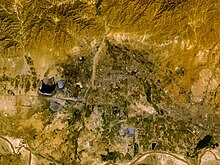Baotou
| Baotou | ||
|---|---|---|
|
|
||
| Coordinates | 40 ° 39 ' N , 109 ° 51' E | |
| Basic data | ||
| Country | People's Republic of China | |
| Inner Mongolia | ||
| ISO 3166-2 | CN-NM | |
| surface | 27,768 km² | |
| Residents | 2,858,000 (2016) | |
| density | 102.9 Ew. / km² | |
| politics | ||
| mayor | Zhao Jiangtao | |
| Mongolian name | |
|---|---|
| Mongolian script : | ᠪᠤᠭᠠᠲ ᠬᠣᠲ |
| Transliteration: | buɣat qota |
| Cyrillic script : | Бугат хот |
| ISO transliteration : | Bugat hot |
| Transcription: | Bugat chot |
| Chinese name | |
| Traditional : | 包頭 市 |
| Simplified : | 包头 市 |
| Pinyin : | Bāotóu Shì |
| Wade-Giles : | Pao-t'ou Shih |
Baotou (chin. 包头) is a district-free city in the Inner Mongolia Autonomous Region of the People's Republic of China . The city is located on the Huang He ( Yellow River ). Remains of the Great Wall of China can still be found near the city . The administrative area of the city of Baotou has an area of 27,768 km² and around 2.858 million inhabitants (end of 2016). This results in a population density of 102.92 inhabitants / km² (end of 2016).
Zhao Jiangtao is the city's mayor (as of 2017).
Administrative structure
The administrative area of the city of Baotou consists of six municipalities, a district and two banners:
- Municipality of Hondlon (昆 都 仑 区Kūndūlún Qū ), 119 km², 440,000 inhabitants;
- Donghe district (东河 区Dōnghé Qū ), 85 km², 380,000 inhabitants;
- Qingshan District (青山 区Qīngshān Qū ), 67 km², 310,000 inhabitants;
- District Shiguai (石拐区Shíguǎi Qū ), km² 619, 60 000 inhabitants;
- City district Bayan Obo (白云 矿区Báiyún Kuàng Qū ), 303 km², 20,000 inhabitants;
- Jiuyuan District (九 原 区Jiǔyuán Qū ), 1,776 km², 220,000 inhabitants;
- Guyang County (固 阳县Gùyáng Xiàn ), 5,021 km², 210,000 inhabitants, main town: Jinshan municipality (金山 镇),
- Right Tumed banner (土默特 右 旗Tǔmòtè Yòu Qí ), 2,368 km², 350,000 inhabitants; Main town: Salq municipality (萨拉齐 镇);
- United Darhan-Muminggan-Banner (达尔罕 茂 明安 联合 旗Dá'ěrhǎn Màomíng'ān Liánhé Qí ), 17,410 km², 110,000 inhabitants, main town: Bail Miao (百灵庙 镇).
population
According to the census (2000), Baotou had 2,254,439 inhabitants.
| Name of the people | Residents | proportion of |
|---|---|---|
| Han | 2,122,737 | 94.16% |
| Mongols | 67.209 | 2.98% |
| Hui | 36,234 | 1.61% |
| Manchu | 22,826 | 1.01% |
| Korean | 848 | 0.04% |
| Daur | 751 | 0.03% |
| Uighurs | 597 | 0.03% |
| Yi | 457 | 0.02% |
| Miao | 450 | 0.02% |
| Bouyei | 396 | 0.02% |
| Zhuang | 314 | 0.01% |
| Tujia | 310 | 0.01% |
| Xibe | 248 | 0.01% |
| Others | 1,062 | 0.05% |
Population development of the agglomeration according to the UN
In 2017, 2.05 million people lived in the city's urban agglomeration. The rest of the population lived in the rural area. Due to the dynamic economic development, the population has increased rapidly in recent years.
| year | population |
|---|---|
| 1950 | 104,000 |
| 1960 | 346,000 |
| 1970 | 754,000 |
| 1980 | 835,000 |
| 1990 | 1,044,000 |
| 2000 | 1,406,000 |
| 2010 | 1,757,000 |
| 2017 | 2,050,000 |
economy
The area around Baotou is known for the world's largest known deposits of rare earth metals . The Bayan-Obo deposits north of Baotou were discovered in 1936 and contain approximately 40 million tons of ore, which is approximately 70% of the known occurrence of these metals. The mining is accompanied by massive environmental pollution. As a result of the degradation process, a large, black-colored lake has been created in which toxic chemicals and waste products collect. The entire environment resembles a lunar landscape.
Literature and individual references
- ↑ Baotou Population: Population Density, Statistics, People living in Baotou. (No longer available online.) Archived from the original on April 13, 2018 ; accessed on April 12, 2018 . Info: The archive link was inserted automatically and has not yet been checked. Please check the original and archive link according to the instructions and then remove this notice.
- ↑ Leadership. Accessed April 12, 2018 .
- ↑ World Urbanization Prospects - Population Division - United Nations. Retrieved July 23, 2018 .
- ↑ Bayan Obo deposit (Bayun-Obo deposit; Baiyunebo deposit). minddat.org, accessed September 19, 2015 .
- ↑ Insight into China's "Hell on Earth", On the Dark Side of Progress , orf.at, May 2, 2015
- ↑ The dystopian lake filled by the world's tech lust , BBC, April 2, 2015
- ↑ The lake from the perspective of Google Earth




